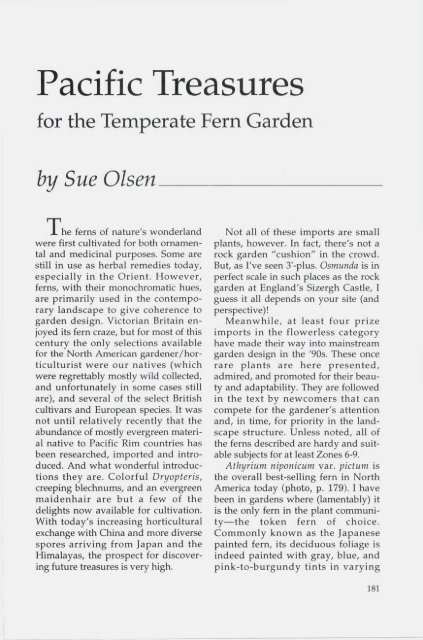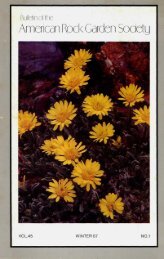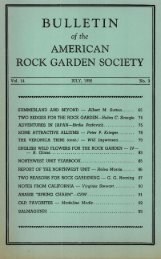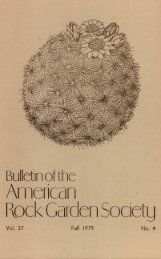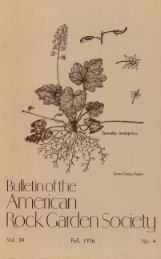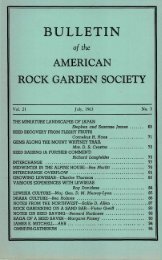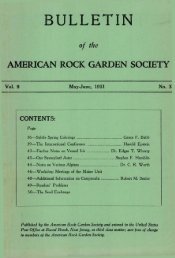Bulletin - Summer 1994 - North American Rock Garden Society
Bulletin - Summer 1994 - North American Rock Garden Society
Bulletin - Summer 1994 - North American Rock Garden Society
Create successful ePaper yourself
Turn your PDF publications into a flip-book with our unique Google optimized e-Paper software.
Pacific Treasuresfor the Temperate Fern <strong>Garden</strong>by Sue OlsenX he ferns of nature's wonderlandwere first cultivated for both ornamentaland medicinal purposes. Some arestill in use as herbal remedies today,especially in the Orient. However,ferns, with their monochromatic hues,are primarily used in the contemporarylandscape to give coherence togarden design. Victorian Britain enjoyedits fern craze, but for most of thiscentury the only selections availablefor the <strong>North</strong> <strong>American</strong> gardener /horticulturistwere our natives (whichwere regrettably mostly wild collected,and unfortunately in some cases stillare), and several of the select Britishcultivars and European species. It wasnot until relatively recently that theabundance of mostly evergreen materialnative to Pacific Rim countries hasbeen researched, imported and introduced.And what wonderful introductionsthey are. Colorful Dryopteris,creeping blechnums, and an evergreenmaidenhair are but a few of thedelights now available for cultivation.With today's increasing horticulturalexchange with China and more diversespores arriving from Japan and theHimalayas, the prospect for discoveringfuture treasures is very high.Not all of these imports are smallplants, however. In fact, there's not arock garden "cushion" in the crowd.But, as I've seen 3'-plus. Osmunda is inperfect scale in such places as the rockgarden at England's Sizergh Castle, Iguess it all depends on your site (andperspective)!Meanwhile, at least four prizeimports in the flowerless categoryhave made their way into mainstreamgarden design in the '90s. These oncerare plants are here presented,admired, and promoted for their beautyand adaptability. They are followedin the text by newcomers that cancompete for the gardener's attentionand, in time, for priority in the landscapestructure. Unless noted, all ofthe ferns described are hardy and suitablesubjects for at least Zones 6-9.Athyrium niponicum var. pictum isthe overall best-selling fern in <strong>North</strong>America today (photo, p. 179). I havebeen in gardens where (lamentably) itis the only fern in the plant community—thetoken fern of choice.Commonly known as the Japanesepainted fern, its deciduous foliage isindeed painted with gray, blue, andpink-to-burgundy tints in varying181


